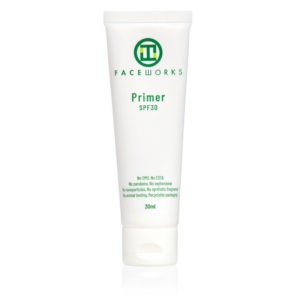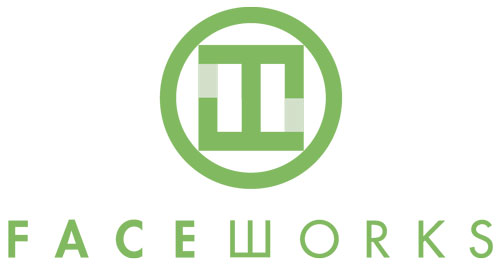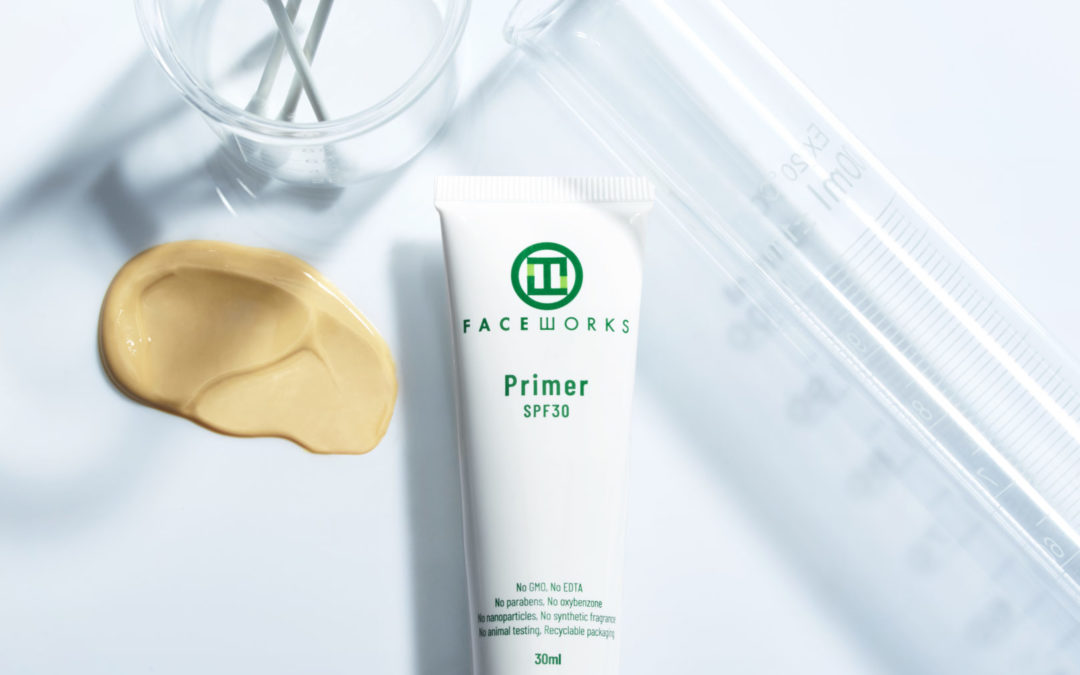
FaceWorks Primer SPF30 is a safe New Zealand made organic sun screen for under makeup.
Applying sunscreen each day is as familiar to you as brushing your teeth or combing your hair, right? Likewise, you understand that sun damage is the primary cause of premature ageing, linked to fine lines, rough skin texture and brown spots and that it can also lead to some types of skin cancer.
But how much do you know about what’s hidden in the ingredients list of your cosmetics and sunscreens?
Is your skincare safe?
There is a growing concern about what’s in our cosmetics and sunscreens, and rightly so. Products that have been commonly used for many years may be damaging our health and negatively impacting on the environment.
So what should you avoid and why?
Endocrine disruptors
Our endocrine glands include the thyroid, pituitary, parathyroid and adrenal glands as well as the pancreas, ovaries, testes, and hypothalamus. These glands have many different, complex functions but all are vital for our health and reproduction. Chemicals that disrupt the functioning of any of our endocrine glands are known as “endocrine disruptors”. A recent report by WHO describes an association with infertility and reproductive problems in both men and women, increased incidence of breast cancer, thyroid cancer and prostate cancer, abnormal growth patterns and neurodevelopmental delays in children, as well as changes in immune function.
Several ingredients still commonly found in sunscreen and skincare products are suspected of being endocrine disruptors – so read the label and avoid the following:
1. PABA (para-amino benzoic acid)
This chemical inhibits the functioning of our thyroid gland as well as increasing skin photosensitivity. It has been found to have the potential to cause cancer in animal studies. Canada and the EU have both banned it.
2. Parabens
Parabens, which are types of preservatives, were first introduced in the 1950s. They’re used to prolong shelf life in many health and beauty products by preventing the growth of mould and bacteria.
In 2004, a British study found traces of five parabens in the breast tissue of 19 out of 20 women studied. The study didn’t prove that parabens can cause cancer but identified that the parabens were able to penetrate the skin and remain within tissue.
Parabens are believed to disrupt hormone function by mimicking oestrogen. Too much oestrogen can trigger an increase in breast cell division and the growth of tumours, which is why paraben use is linked to breast cancer and reproductive issues.
The parabens used most commonly in cosmetics are methylparaben, propylparaben, butylparaben, and ethylparaben.
Parabens don’t just affect humans; studies have identified parabens in the bodies of marine mammals.
Researchers believe that it is likely these cosmetic-related parabens are washed into the sewage system and released into the environment.
3. Oxybenzone
Oxybenzone is still used in many popular sunscreens, although it has clearly been shown to damage coral and affect marine life. It is banned in Hawaii, and more countries will hopefully follow. It may also be an endocrine disruptor, mimicking oestrogen.
4. EDTA
EDTA is a compound widely used as a cheating agent in many skincare products, as it increases the stability of the product in the air. Laboratory animal studies have suggested it has an effect on reproduction and development as an endocrine disruptor. There are lots of safer alternatives that manufacturers could use.
5. Nanoparticles
Some of the mineral sunscreens in a spray or aerosol form contain very fine particles (nanoparticles) which are small enough to enter the lungs and have been linked with serious respiratory disease.
These concerns prompted FaceWorks to develop a new daily sun protection for the face. We set the bar very high. We wanted to develop the best and safest Primer SPF30 for wearing under makeup. It needed to be completely free of any of these five potential health hazards.
Not only did our new Primer have to be safe we had plenty of other things on our wish list before we were happy. These are some of them:
It had to have organic sun filters because they work well when applied in a thin layer on the skin. For mineral sunblocks to be effective, they need to be applied in a thicker layer, which we knew some clients find unpleasant to wear so we didn’t want to use minerals.
- Work well under makeup but also feel great without makeup
- Feel silky and light
- Glide on easily
- Be moisturising for dry skin ( which most of us have)
- Have an SPF30 to be effective protection in our harsh environment
Why is FaceWorks Primer SPF30 safe to put on your skin?
That’s simple: No Parabens, no PABA, no EDTA, no Nanoparticles, no Oxybenzone
| FaceWorks Primer SPF30 |
|---|
| No Parabens No PABA No EDTA No Nanoparticles No Oxybenzone Not tested on animals |
It took more than 2 years of development in our laboratory here in Auckland. We tested more than 12 different formulations. I’m proud to say we’ve succeeded.
And here it is – FaceWorks Primer SPF30, $45 for 30g, available at faceworks.co.nz (free NZ delivery).
New-generation safe sun protection – made with ingredients that are safer for you and better for the environment.
Proudly made in New Zealand and not tested on animals.
FACT: The sunscreen factor added to foundation is not adequate for Australasia’s harsh sun; the SPF isn’t high enough and foundation is applied in too thin a layer for it to be effective.

